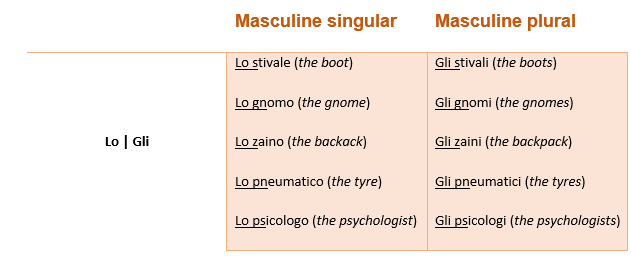Nouns are words that name people, things, feelings, ideas and phenomena. They are generally divided in common name (referring to something general) or proper name (identifying a particular person, place, animal, institution).
See our list of the top 100 Italian nouns.
Gender
Just like other European languages, Italian nouns have both a feminine and a masculine form. Generally, it is very easy to determine the gender of a noun, based upon its ending.

Study tip! Nouns ending in “-ista” can be both feminine and masculine. For example, farmacista can refer both to a female or to a male pharmacist.
Number
When writing or speaking in Italian, you do not add “s” or “es” to the noun you want to make plural. You just need to change the final vowel.
“One of the most important areas we can develop as professionals is competence in accessing and sharing knowledge”
To learn more about Italian language, ENROLL NOW to our Italian Course
How to use definite articles before Italian nouns
Definite and indefinite articles must be masculine or feminine, singular or plural, in order to agree with the noun. If you want to choose correctly, you just need to take into consideration how your noun ends. Let’s have a look at the following chart!

“Lo” is a definitive article used before masculine singular names that begin with the letter “s” followed by another consonant or that begin with letter “z”. It is also used with other letter combinations, such as “gn”, “pn” and “ps”. Its plural form is “gli”.

“L’” is simply the elided form of “lo”, used before a masculine noun which begins with a vowel. Thus, the “o” is replaced by an apostrophe. The plural form remains “gli”. Although plural forms are not elided, you may still decide to omit part of the article if the word that follow starts with a “i”.

“Il” is the most common Italian definite article. It is used with nouns that begin with any consonant and that do not require the use of “lo”.

Feminine definite articles are easier to use. You do not have to check how the word begins. “La” is the definite articles used with nouns that start with every consonant. Its plural form is “le”. As with its masculine form, “la” is elided when the singular noun begins with a vowel, and it becomes “l’”.
Indefinite articles with Italian nouns
Indefinite articles do not have any plural form. The only thing that you need to remember is that there are two forms for each gender of nouns.

“Uno” is used before a singular masculine noun that begins with “s”, “z”, “gn”, “ps” and “pn”. When a masculine noun begins with a vowel, we use the article “un”, without the apostrophe.

“Una” is the indefinite article used with feminine nouns that begins with any consonant. “Un’” is used with feminine nouns that begins with a vowel and it always need the apostrophe.
To learn more about Italian language, ENROLL NOW to our Italian Course



